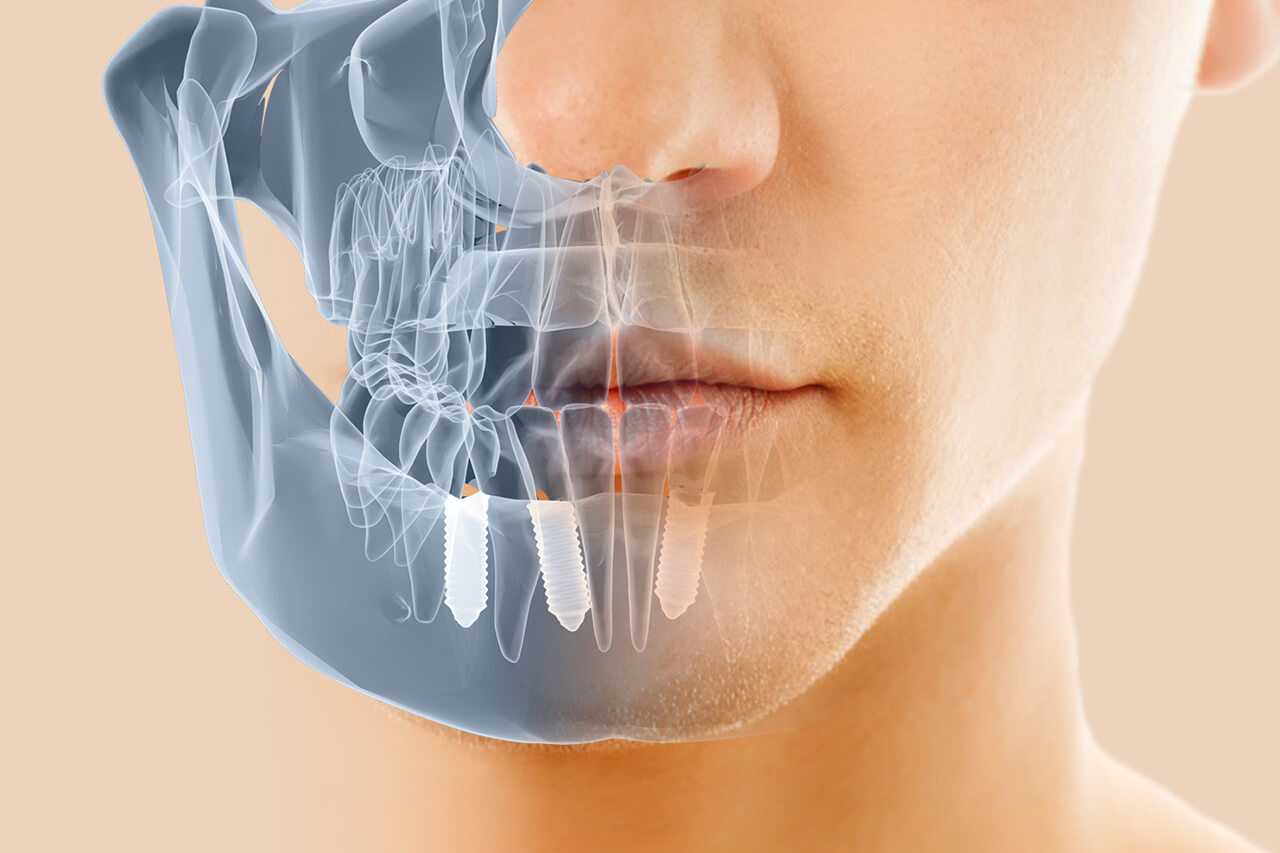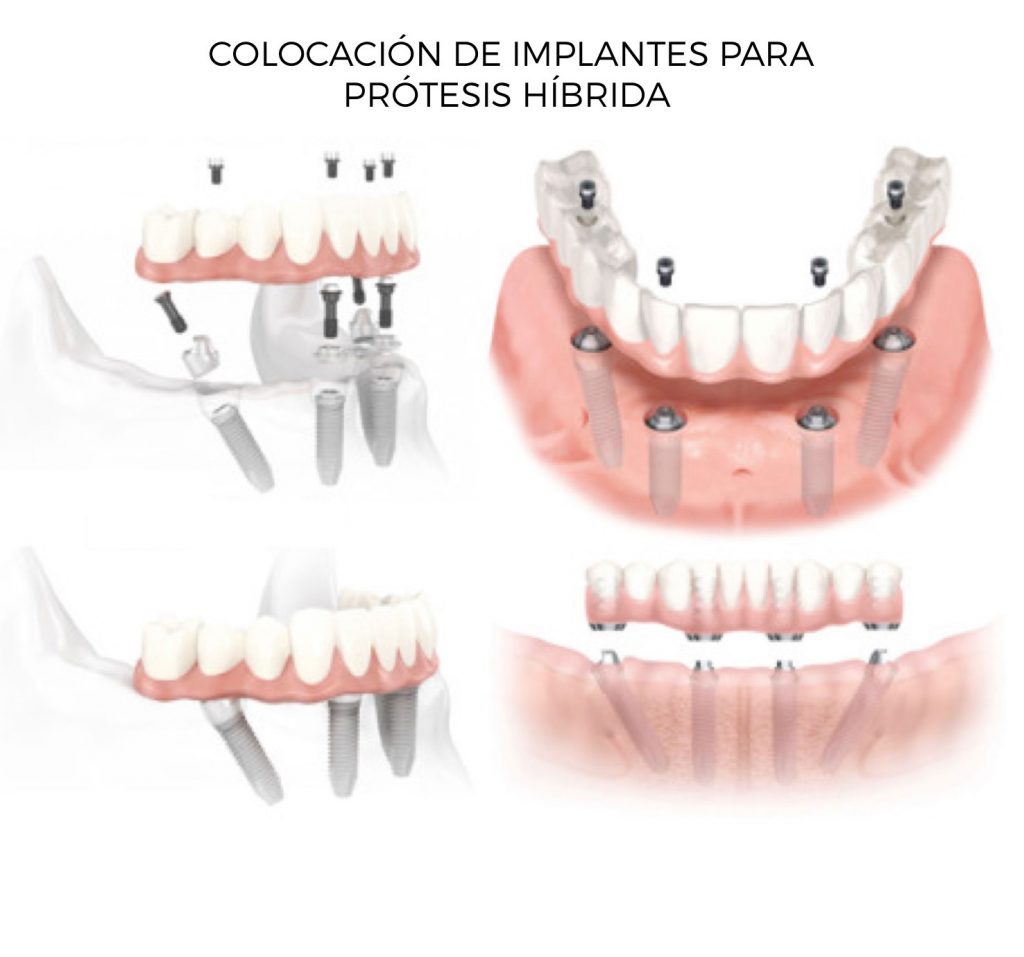Implantes Dentales Salou Tarragona < Especialidades < Clínica Dental Salou Tarragona

Implantology
Dental Implants Salou Tarragona
The implant is a screw-like cylinder with a thread, usually with a rough surface, usually made of titanium and sometimes zirconium.
Once the implant has been placed in the maxillary or mandibular bone, and after at least two months, the bone is joined to the roughness of the implant surface, producing what is called OSTEOINTEGRATION, which establishes lasting stability. Afterwards, the implant can receive a definitive screwed or cemented cover, re-establishing the function and aesthetics of the mouth. Sometimes, depending on the quantity and quality of the receptor bone, a temporary cover or prosthesis can be placed on the same day of the surgery until the bone integration of the implant takes place.
There are several reasons why the implant outperforms the conventional prosthesis. The most important is that it does not have to damage and destroy the teeth adjacent to a toothless space, which has to be done for a porcelain bridge. It offers security in a complete prosthesis due to its immobility. It is also a durable, aesthetic and safe treatment (success rate 95 - 98%).
There is no operative pain, as the local anaesthesia used makes it impossible. Our clinic also offers treatments with intravenous sedation under the supervision of an anaesthetist, which means that the patient is more relaxed, thus eliminating any possibility of pain.
In recent years, MIS (Minimally Invasive Surgery), which can be blind (MISC - Minimally Invasive Blind Surgery) or guided (MISG - Minimally Invasive Guided Surgery), has been developed for the benefit of the patient. In CMIC, the patient needs to have a good amount of bone in height and width in order not to miss the implant placement, as it is performed through a small diameter hole without the need for a flap or sutures.
CEMI requires 3D images produced by a CT (Cone Beam Axial Topography). These images, in conjunction with dental software, allow implants to be placed virtually. With this information, a surgical guide is produced that maintains the inclinations, angles and depths of the virtual treatment, placing the implants in the most suitable position. It is important to know that all MIS, when performed through an orifice of 4 or 5mm in diameter and without a flap, has a much lower postoperative response (inflammation and pain) than traditional implant surgery.
Our surgery has a state-of-the-art CAT scanner. Therefore, patients who decide to undergo these cutting-edge treatments will not have to travel to a radiology centre.
Lo mejor para ti: guías quirúrgicas
En nuestro afán por cumplir con la excelencia odontológica, hemos incorporado a nuestra clínica la aplicación de guías quirúrgicas.
Una guía quirúrgica es un elemento protésico provisional que mejora la planificación de una cirugía de implantes y potencia la precisión de su colocación para asegurar un resultado exitoso.
Con objeto de minimizar errores y perfeccionar la técnica, las guías son elaboradas mediante tecnología 3D que reproduce a la perfección tu estructura bucal: escáner intraoral, estudio 3D TAC-CBCT, diseño digital e impresión en 3D.
Gracias a su aplicación conseguimos mayor precisión y exactitud en la colocación del implante, mejorando su estabilidad, aceleramos los tiempos de la cirugía, minimizamos la abertura de la encía y, por tanto, evitamos suturar. Como consecuencia, la cicatrización y el tiempo de recuperación post-cirugía serán mucho más rápidos y seguros.
HYBRID PROSTHESES
Hybrid prostheses are a particular type of fixed prosthesis made of metal and resin or zirconium, and are always screw-retained. This type of prosthesis is only used in completely edentulous cases to restore a complete maxillary or mandibular dental arch. Between 4 and 6 implants are placed per arch.
- Hybrid resin prosthesis:
These prostheses have a metal structure that provides strength and is covered with pink acrylic resin which in turn supports artificial resin teeth. Nowadays, the metal structure is designed and manufactured by computer (cad cam), which means that great precision is achieved. In addition, today's resins allow aesthetics to be achieved at almost the same level as ceramics.
It is a type of prosthetic rehabilitation that should be used when the patient has not only lost teeth but has also lost or is expected to lose part of the bone and gum. The pink resin on the metal framework allows the missing bone and gum to be replaced in addition to the teeth. It thus gives the patient self-confidence, thanks to the good aesthetics, functionality and comfort it provides. It is the ideal choice for implant-supported fixed prosthetic restorations for patients with little available bone.
- Hybrid zirconium prosthesis:
Zirconium is a white metal, which gives it a strength equal to that of resin with a higher aesthetic factor. Like the previous one, it is made with cAD-cam and covered with porcelain.
More information at
- Our treatment section -> Specialities
- Our Youtube Channel -> Yotube Channel Clinica Dental Salou Tarragona
- Our Blog articles -> Clínica Dental Moreno-Montalvo Blog
Dental Implants
Request your visit and smile again




